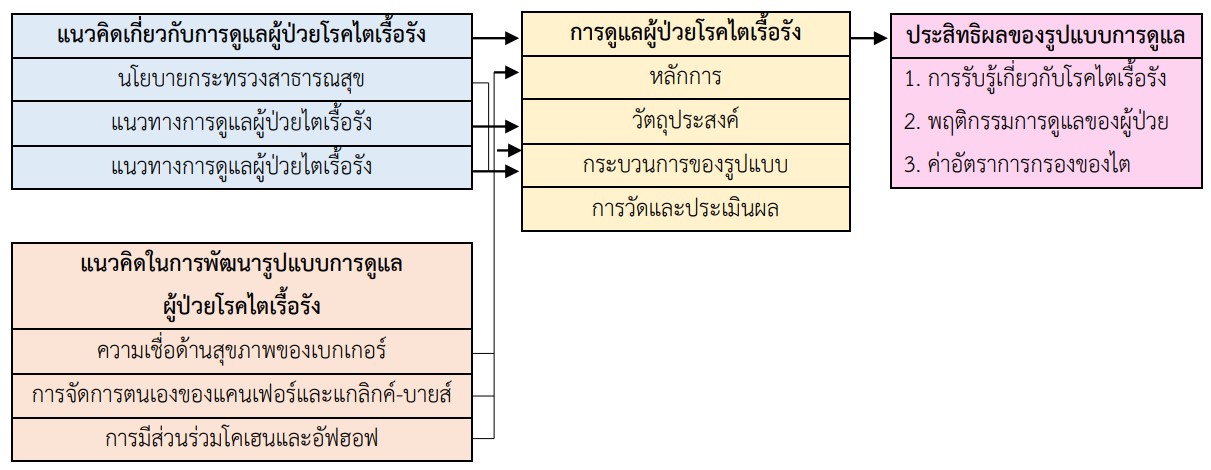The Development of Caring Model for Patients with Chronic Kidney Disease in the Community, Nonthaburi Province
Keywords:
Development, Caring Model, Chronic Kidney Disease, CommunityAbstract
This research and development study aimed to develop and evaluate the effectiveness of a care model for chronic kidney disease patients in the community of Nonthaburi Province. The research was conducted in three phases: Phase 1 - problem situation analysis, Phase 2 - developing the care model, and Phase 3 - evaluating the effectiveness of the care model. Participants consisted of 29 chronic kidney disease patients in the Nonthaburi Province community. The research tools included a care model for chronic kidney disease patients in the community. The data collection tools consisted of a questionnaire on chronic kidney disease perception, a self-care behavior assessment form for chronic kidney disease patients, and a personal record book. General data was analyzed using descriptive statistics. The average scores of chronic kidney disease perception and glomerular filtration rate before and after using the care model were compared using a Paired t-test. The average scores of self-care behaviors, as assessed by the patients themselves over four instances, were compared using Repeated Measure ANOVA.
The research results revealed that the care model for chronic kidney disease patients in the community comprises a five-step process: step 1 - building understanding, step 2 - empowering positivity, step 3 - promoting sustainable practices, step 4 - encouraging participation, and step 5 - evaluation and follow-up. The evaluation of the effectiveness of the care model for chronic kidney disease patients in the community showed that: 1) the average score of chronic kidney disease awareness after using the care model was significantly higher than before using it (p-value < 0.001); 2) the average self-care behavior scores of the sample group from the four assessments differed significantly (p-value < 0.001); and 3) the average glomerular filtration rate before and after using the care model did not differ significantly (p-value = 0.55). Based on the research results, healthcare personnel can adapt this care model to their own settings to improve chronic kidney disease patients' awareness and foster appropriate and continuous self-care behaviors.
References
กนก เจริญพันธ์. (2566). การพัฒนารูปแบบการดูแลผู้ป่วยโรคไตเรื้อรังระยะที่ 4. วารสารศูนย์อนามัยที่ 9, 17(2), 543-558.
กระทรวงสาธารณสุข. (2566). ระบบคลังข้อมูลสุขภาพ (Health Data Center: HDC): จำนวนผู้ป่วยโรคไตเรื้อรังในเขตรับผิดชอบ จำแนกตาม Stage. สืบค้นเมื่อ 17 พฤศจิกายน 2566 จาก https://shorturl.asia/xQY47.
ธวัช วิเชียรประภา. (2566). ผลของรูปแบบการชะลอไตเสื่อมด้วยกระบวนการมีส่วนร่วมของชุมชนสำหรับผู้ป่วยโรคไตเรื้อรัง อำเภอขลุง จังหวัดจันทบุรี. วารสารวิจัยทางวิทยาศาสตร์สุขภาพวิทยาลัยพยาบาลบรมราชชนนี จังหวัดนนทบุรี, 17(3), 65-76.
พันธ์ศักดิ์ บาลนคร, นภชา สิงห์วีรธรรม, กิตติพร เนาว์สุวรรณ และมารุต ภู่พะเนียด. (2566). ผลของโปรแกรมการจัดการตนเองต่อค่าอัตราการกรองของไตของผู้ป่วยโรคความดันโลหิตสูงที่มีโรคร่วมไตเรื้อรังระยะที่ 3. วารสารวิจัยการพยาบาลและการสาธารณสุข, 3(2), 52-62.
ยิ่งยศ อวิหิงสานนท์ และปิยะวรรณ กิตติสกุลนาม. (2561). โรคไต: คู่มือป้องกันและดูแลผู้ป่วยโรคไต ฉบับสมบูรณ์. กรุงเทพฯ: อมรินทร์เฮลท์ อมรินทร์พริ้นติ้งแอนด์พับลิชชิ่ง.
วันชัย พันศรี, พาณี สีตกะลิน และสมจิตต์ สุพรรณทัสน์. (2562). การพัฒนารูปแบบการบริหารจัดการยาของผู้ป่วยไตเรื้อรังในโรงพยาบาลชุมชนแห่งหนึ่ง จังหวัดอุดรธานี. วารสารการแพทย์โรงพยาบาลอุดรธานี, 27(3), 261-271.
ศิริวรรณ พายพัตร, น้ำอ้อย ภักดีวงศ์ และวารินทร์ บินโฮเซ็น. (2564). ความสัมพันธ์ระหว่างความรู้และการรับรู้สมรรถนะแห่งตนกับพฤติกรรมการจัดการตนเองในผู้ป่วยโรคไตเรื้อรัง. วารสารการพยาบาลและสุขภาพ สสอท, 3(2), 22-36.
สมาคมโรคไตแห่งประเทศไทย. (2560). คำแนะนำสำหรับการดูแลรักษาโรคไตเรื้อรังแบบองค์รวมชนิดประคับประคอง. กรุงเทพฯ: เท็กซ์ แอนด์ เจอร์นัล พับลิเคชั่น จำกัด.
สุนีรัตน์ สิงห์คำ. (2559). การพัฒนารูปแบบการดูแลผู้ป่วยโรคไตเรื้อรังในชุมชนโดยการเสริมสร้างพลังภาคีเครือข่ายแบบมีส่วนร่วม. วารสารโรงพยาบาลมหาสารคาม, 13(3), 92-99.
สุภลักษณ์ ธานีรัตน์, เมทณี ระดาบุตร, สุจิรา วิเชียรรัตน์ และวิญญา สุมาวัน. (2564). การรับรู้และประสบการณ์ในการดูแลตนเองของผู้ป่วยโรคไตเรื้อรังในชุมชน. วารสารวิจัยทางวิทยาศาสตร์สุขภาพ, 15(3), 83-94.
สุภาภรณ์ แก้วชนะ และวนรัตน์ อนุสรณ์เสงี่ยม. (2564). การพัฒนารูปแบบการดูแลผู้ป่วยโรคไตเรื้อรัง โดยสหวิชาชีพ ณ โรงพยาบาลนางรอง. วารสารเภสัชกรรมไทย, 12(4), 195-206.
สุวคนธ์ เหล่าราช และละออง เดิมทํารัมย์. (2564). การพัฒนารูปแบบการดูแลผู้ป่วยโรคไตเรื้อรังระยะที่ 3 ในผู้ป่วยโรคเบาหวาน และโรคความดันโลหิตสูง อำเภอนาดูน จังหวัดมหาสารคาม. วารสารวิจัยและพัฒนานวัตกรรมทางสุขภาพ, 2(1), 99-111.
สุวรรณา สุรวาทกุล, สุวคนธ์ เหล่าราช และละออง เดิมทำรัมย์. (2563). การพัฒนารูปแบบการดูแลผู้ป่วยโรคไตเรื้อรังระยะที่ 4 อำเภอนาดูน. วารสารวิชาการสำนักงานสาธารณสุขจังหวัดมหาสารคาม, 4(7), 129-143.
Baba, M., et al. (2015). Study of the decline in renal function in healthy subjects. PLoS One, 10(6), e0129036. https://doi.org/10.1371/journal.pone.0129036
Becker, M. H., & Clark, N. M. (1998). Theoretical model and strategies for improving adherence and diseases management. In A. S. Sally, B. S. Elenor, K. O. Judith, & L. M. Wendy (Eds.), The Handbook of Health Behavior Change (2nd ed.). (pp. 5-26). New York: Springer.
Best, J. W., & Kahn, J. V. (2006). Research in education. (10th ed.) Boston: Pearson education Inc.
Cohen, J. & Uphoff, N.T. (1980). Participation in rural development: Seekingclarity through Specificity. World Development, 8(13), 219-221. https://doi.org/10.1016/0305-750X(80)90011-X
Cohen, J. (1988). Statistical power analysis for the behavioral sciences. (2nd ed.) Hillsdale, NJ: Lawrence Erlbaum Associates.
Datta, P., & Ogbeide, S. A. (2019). Managing chronic kidney disease: Considerations for behavioral health intervention in primary care. Practice Innovations, 4(4), 255-264. https://doi.org/10.1037/pri0000101
Faul, F., Erdfelder, E., Buchner, A., & Lang, A.-G. (2009). Statistical power analyses using G*Power 3.1: Tests for correlation and regression analyses. Behavior Research Methods, 41, 1149-1160.
International Society of Nephrology. (2023). ISN-Global Kidney Health Atlas 2023. Retrieved August 10, 2023 from https://shorturl.asia/0jLeF.
Kanfer, F. H., & Gaelick-Buys, L. (1991). Self-management methods. In R. B. Taylor (Ed.), Health Psychology. New York: McGraw-Hill.
Narva, A. S., Norton, J. M., & Boulware, L. E. (2016). Educating patients about CKD: The Path to Self-Management and Patient-Centered Care. Clinical Journal of The American Society of Nephrology: CJASN, 11(4), 694-703. https://doi.org/10.2215/CJN.07680715
Noronha, I. L., Santa-Catharina, G. P., Andrade, L., Coelho, V. A., Jacob-Filho, W., & Elias, R. M. (2022). Glomerular filtration in the aging population. Frontiers in Medicine, 9, 769329. https://doi.org/10.3389/fmed.2022.769329
Polonia, J., Azevedo, A., Monte, M., Silva, J. A., & Bertoquini, S. (2017). Annual deterioration of renal function in hypertensive patients with and without diabetes. Vascular Health and Risk Management, 13, 231-237. https://doi.org/10.2147/VHRM.S135253
Schrauben, S. J., et al. (2019). The Relationship of Disease-Specific Knowledge and Health Literacy with the Uptake of Self-Care Behaviors in CKD. Kidney International Reports, 5(1), 48-57. https://doi.org/10.1016/j.ekir.2019.10.004
Selman, L.E., Bristowe, K., Higginson, & Murtagh, F.E. (2019). The views and experiences of older people with conservatively managed renal failure: A qualitative study of communication, information and decision-making. BMC Nephrol, 20(38), 1-12. https://doi.org/10.1186/s12882-019-1230-4
Tuckey, N., Duncanson, E., Chur-Hansen, A., & Jesudason, S. (2022). Using an international online forum to explore perspectives of caregivers of patients with chronic kidney disease. Journal of Nephrology, 35(1), 267-277. https://doi.org/10.1007/s40620-021-01216-6

Downloads
Published
How to Cite
Issue
Section
License
Copyright (c) 2024 Journal of Nursing and Public Health Research

This work is licensed under a Creative Commons Attribution-NonCommercial-NoDerivatives 4.0 International License.
1. บทความหรือข้อคิดเห็นใด ๆ ที่ปรากฏในวารสารวิจัยการพยาบาลและการสาธารณสุข ที่เป็นวรรณกรรมของผู้เขียน บรรณาธิการไม่จำเป็นต้องเห็นด้วย
2. บทความที่ได้รับการตีพิมพ์ถือเป็นลิขสิทธิ์ของ วารสารวิจัยการพยาบาลและการสาธารณสุข








